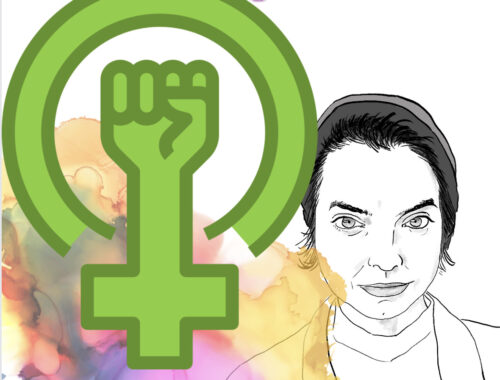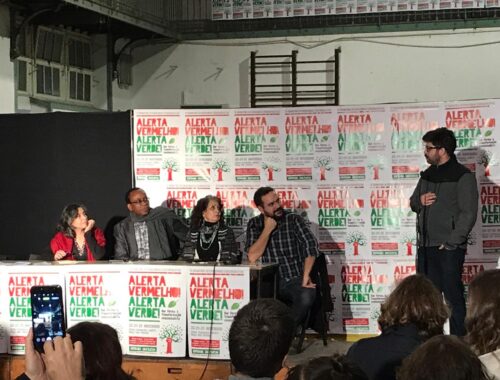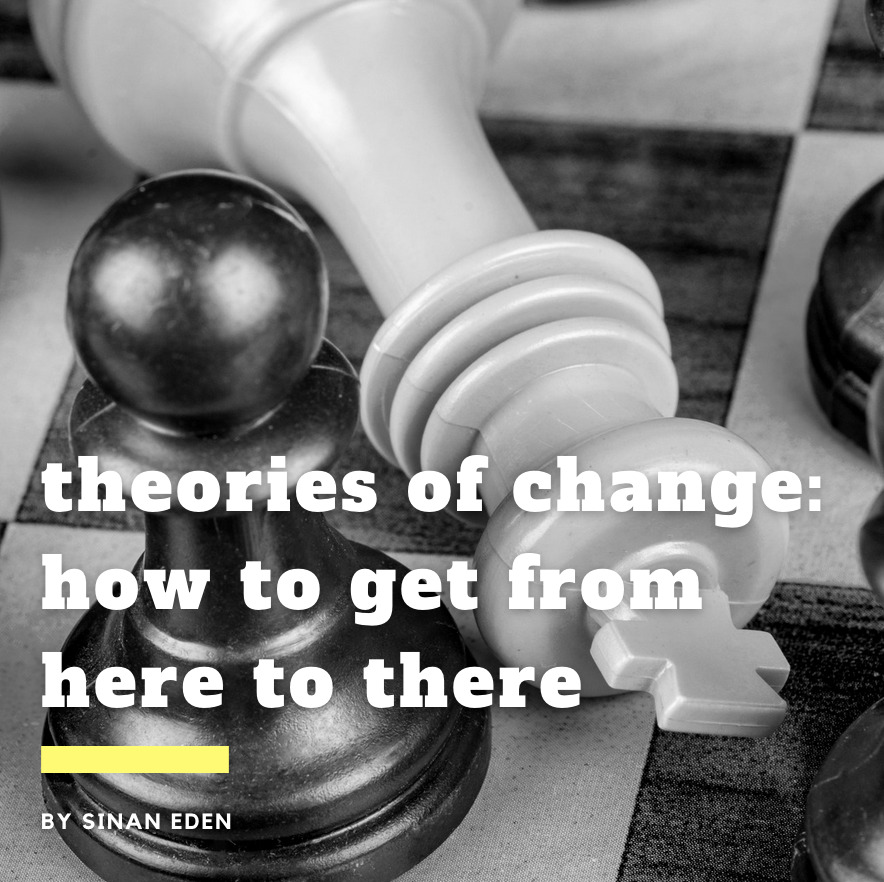
Theories of change: how to get from here to there
By Sinan Eden
§1. There is a slogan: system change not climate change. It’s a famous slogan… frequently used. Most of the time, people who use it don’t pay attention to its meaning. It seems to me that many people use it as shortcut to “capitalism causes climate collapse” (descriptive) and not as “we will change the system in order to avoid climate collapse” (propositional). I’ll follow the latter interpretation.
§2. So if we want to change the system, then we need a theory of how change happens in society. On that theory, we would build our transformative strategy.
If we are serious about system change, as in if we are serious that we claim to be the people who will change the system, then we need to discuss theories of change and transformative strategies explicitly.
History is filled with theories of change that worked pretty well, which makes the discussion a lot harder: our background, our preferences and our ideological predispositions jump in, and we read the past through them.
You can read the first article on theories of change by pressing here.
§3. When we think of changing the capitalist system as an operational question, the first essential example is the Leninist theory of change:
Working class organization + Vanguard organization
→ Economic struggle + Political struggle
→ Revolutionary conditions
→ Popular alliance
→ Seize power via revolution
→ Institute Socialism
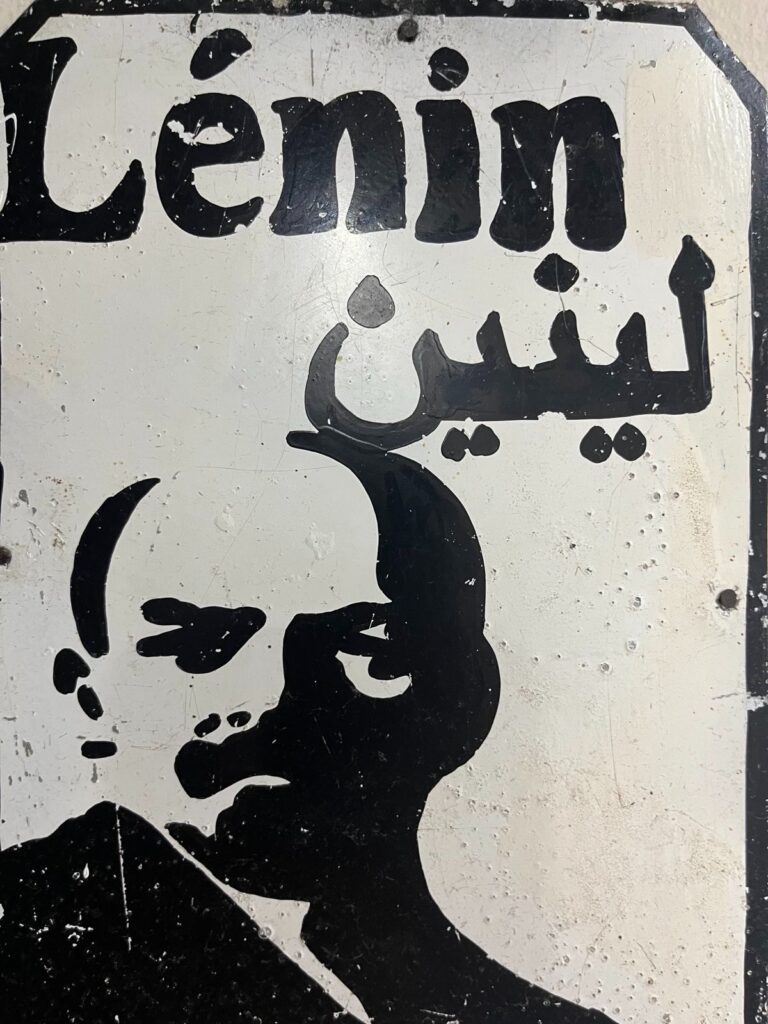
Vladimir Lenin wrote about his strategy before, during and after the revolution. He identified the main function of the party to be mass agitation, guiding the political struggle and preparing the revolutionary conditions and preparing for the revolutionary conditions. It depended on a mix of soviets (popular organizations), trade unions (class organizations) and the communist party.
Lenin’s theory of change had enormous impact on everything that followed: first of all, it was successful; second of all, it changed reality by introducing real socialism into life.
Hundreds if not thousands of political parties were formed following the party model idealized in Lenin’s writings. None managed to replicate its success.
§4. The Bolshevik revolution started a brand new debate on what to do with limited power. Trotsky defended permanent revolution while Stalin adopted Bukharin’s idea of socialism in one country. Trotsky’s and Stalin’s positions produced their corresponding -ism’s that disagreed on two aspects: what exactly happened in the October revolution, and what needs to happen now.
The Trotskyist theory of change was/is:
Mass organization
→ Socialist revolution (led by the party)
→ Intervention and agitation in other countries
→ World revolution.
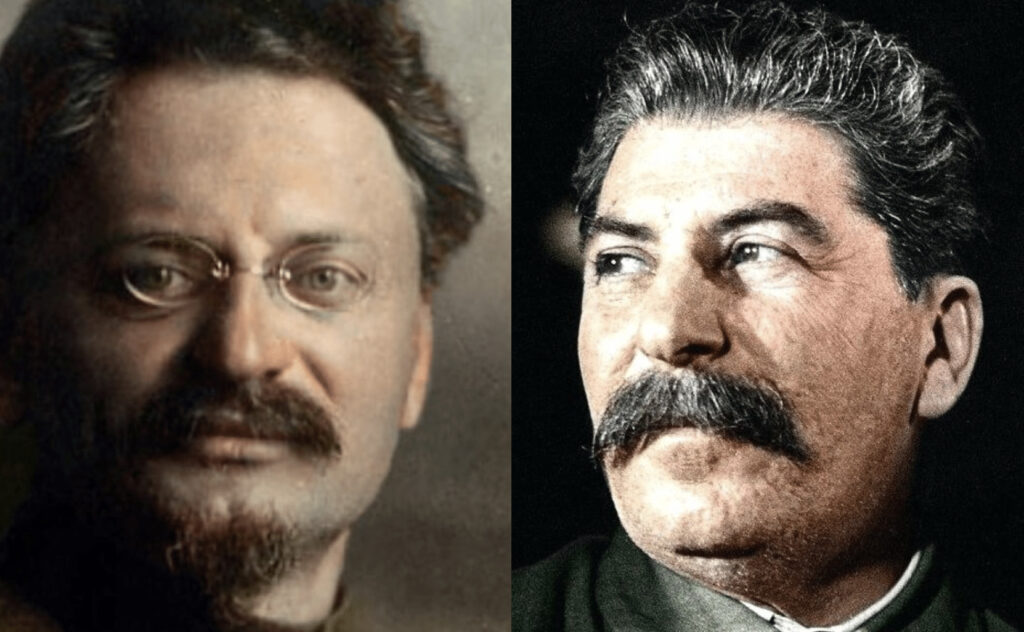
The Stalinist theory of change was/is:
Class party
→ Socialist revolution (organized by the party)
→ Institution of socialism
→ International solidarity
The difference between “international movement” and “internationalism of national movements” marked the 20th century struggles. As revolutionary models, while being tested, the Stalinist model worked: the Soviet Union defeated the Nazis, emancipated Eastern Europe and supported other revolutions in Northern Africa, Palestine, Afghanistan, Korea, Cuba, Southeast Asia and Sub-Saharan Africa. In a couple of decades half of the world had a socialist government of some kind.
§5. The anti-colonial struggles introduced their own perspectives.
The main problematic for Mao Zedong, leader of the Chinese revolution in 1949, was the historical dialectical process in the countries where capitalism did not develop naturally but was imposed by force. His understanding was that imperialism created a de-industralization process and did not allow the urban industrial class to develop in the colonized countries. This negative integration of the Third World countries into the imperialist world order meant that in these countries the peasants would have a leadership role.
The Maoist theory of change, followed by so many organizations all across the world, was/is:
Popular party organization
→ Protracted People’s War (mobile warfare + guerrilla warfare)
→ Seizure of popular power
→ Democratic revolution
→ Large cross-class alliance + Industrialization
→ Proletarianization of the society and of the party
→ Transition to socialism
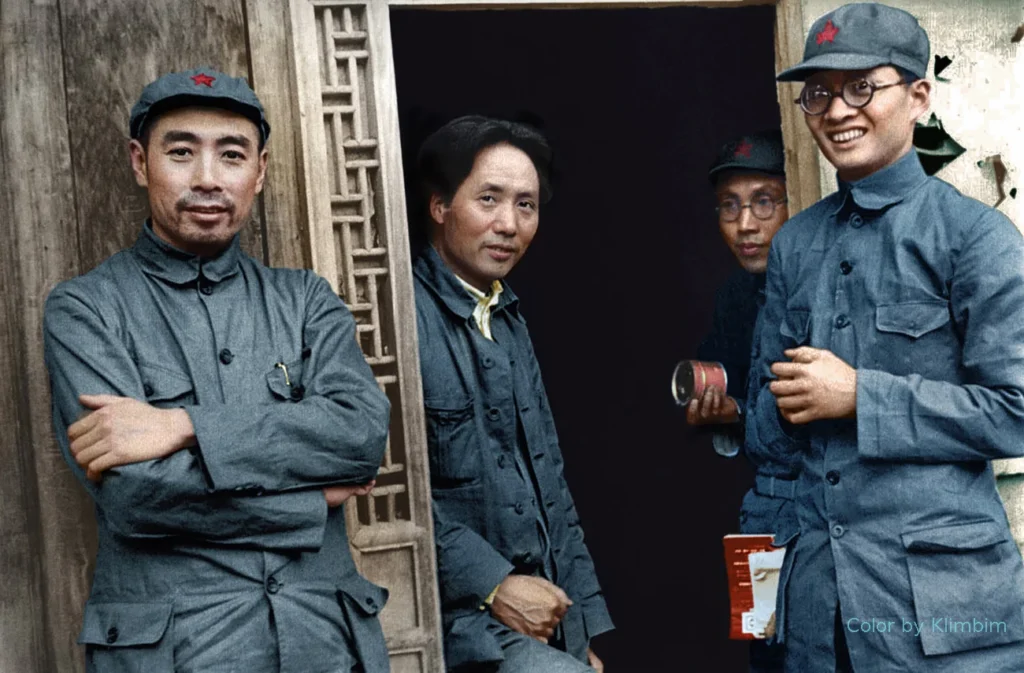
Accordingly, the role of the communist party was not to be communist-as-such but rather lead the society to ripen the conditions for a communism to come. These organizations thus relied on alliances with parts of the bourgeoisie that they considered progressive.
This theory of change worked, too (in fact, if you ask the Chinese Communist Party today, they would say they are still following it methodically).
§6. A variant of the Maoist theory of change was used by the guerrilla movements. Despite their ideological differences, the Viêt Minh revolution (1945), the Cuban revolution (1953-1959), the Irish Republican Army (1919-1921) and Öcalan’s Kurdish liberation party PKK (1978 onwards) all followed more or less the same theory of change:
Armed vanguard organization
→ Guerrilla breaks the “artificial equilibrium” (focism)
→ Mass mobilization
→ Mass organization
→ Revolution
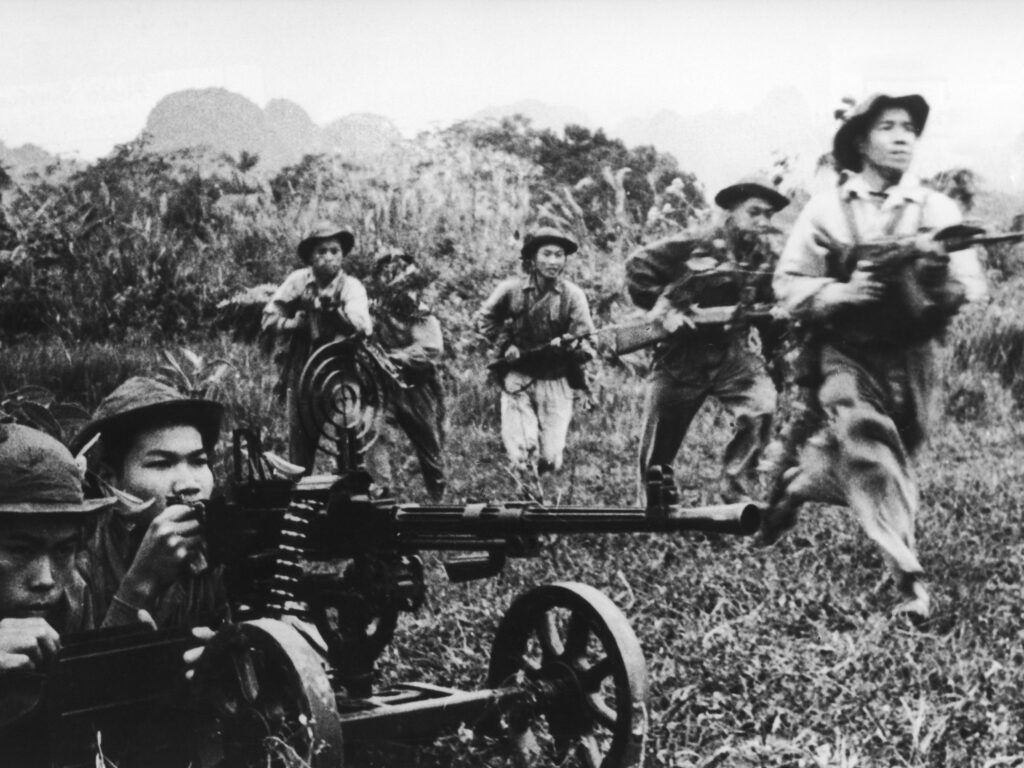
Here, the causality is reversed. We would generally assume that mass mobilization would escalate into violence, while here violence is a precondition for mass movement. Organized violence against the oppressor is expected to negate the dehumanization of the colonized. By seeing the fragility of the regime, the people would wake up, build their agency and liberate themselves. (The textbook example of this theory of change is the Algerian revolution). This theory of change also worked. It is probably the only theory of change that worked in more than one country.
§7. The collapse of the Soviet Union and the decline of Third Worldism (in other words, the rise of neoliberalism) opened up new debates while also reducing the robustness of the new theories of change.
Discussions on class and on organization marked the last decades of the 20th century. The feminist movement insisted that the working class was much more than the industrial workers. The anti-colonial struggles insisted that indigenous movements didn’t have to proletarianize to be considered as historical agents. Much more attention was given to direct democracy and decentralized power.
Antonio Negri, John Holloway, Murray Bookchin and Silvia Federici all contributed to this exploration, while the Zapatista movement and the later stages of the Kurdish liberation movement experimented with autonomism and democratic confederalism.
Their theory of change is:
Armed vanguard organization of the class
→ Seizing local power
→ Self-management
→ Mass organization
→ More vanguard organizations in other places.
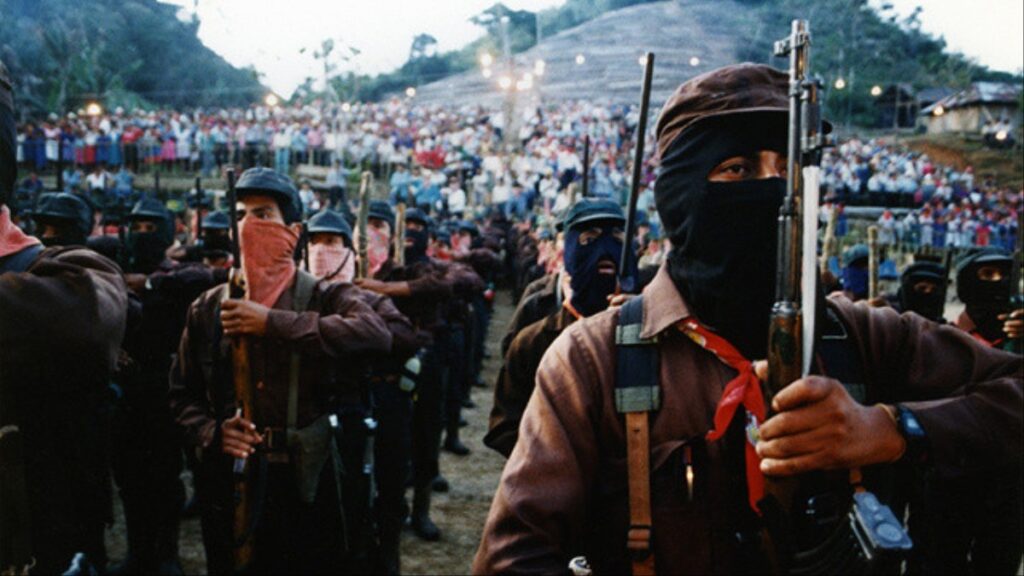
This theory of change is less tested than others, in the sense that their success is limited by design. The Zapatista movement and the Rojava revolution are shining examples of what is promised to be the showcases of an emancipated future for all.
§8. As capital globalized, it also created a more complex and more ambiguous reality. Urbanization accelerated throughout the world. The middle classes were integrated to the proletariat (or to the precariat, if you prefer). Financialization changed the nature of how markets operate. The ecological crisis became a pressing issue. Intersectionality was developed as a theoretical framework for oppressive systems.
Accompanying these discussions, the new social movements built their own theory of change:
Popular grassroots organizations
→ Movement ecosystem (mass organizations, vanguard organizations, thematic organizations, political organizations, etc.)
→ Trigger event (real or perceived, artificial or spontaneous, natural or social)
→ Mass mobilizations
→ Social and/or political change.
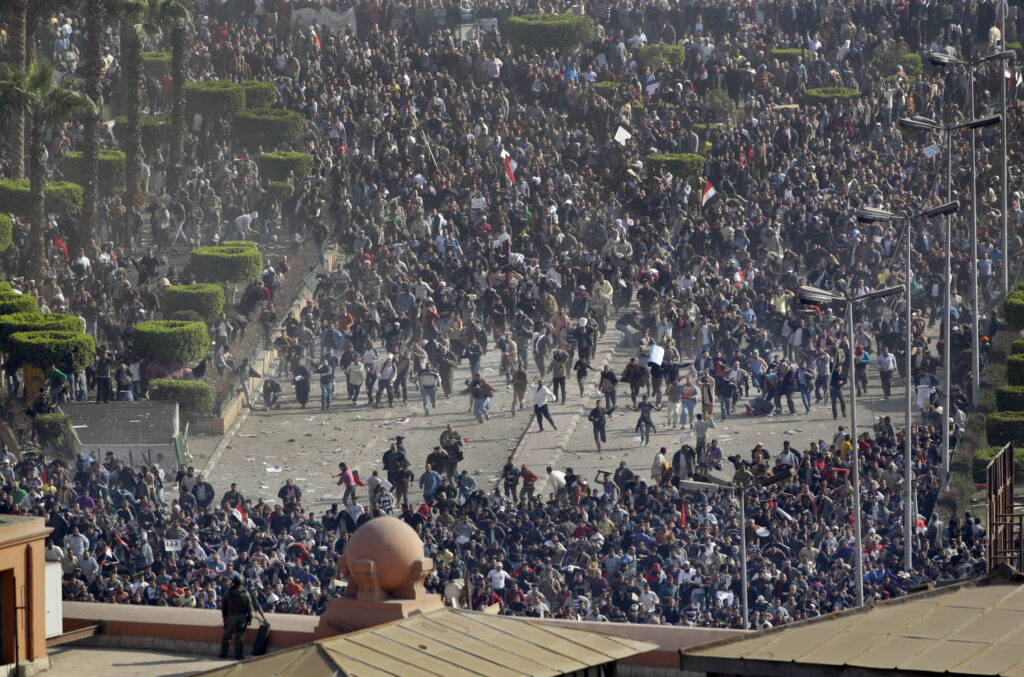
This is the dominant theory of change in which we all operate today. This theory of change worked in many parts of the world for a variety of issues. But it worked for what it aimed to achieve: social and/or political change. It is the only theory of change that we analyzed that does not aim at changing the socioeconomic system. In this sense, this theory of change is an offspring of the neoliberal worldview.
§9. So we reached a contradiction.
On one hand, we have a growing climate justice movement that gets more and more radical as the governments and corporations lead us to societal collapse. Even for the moderate flank of this movement, the need for system change is a pressing political reality.
On the other hand, this movement is strategizing under a framework that structurally blocks a system change perspective. The theory of change of even the most radical flank of the climate justice movement doesn’t have a post-capitalistic society in its horizon.
The result is reduced credibility: If we tell the public that something should happen and if we don’t have any transformative strategy to get there, then the natural result is a mix of defeatism/submissiveness (for the public) and depression/burnout (for the activists).
§9.1 I open a parenthesis here to highlight the organizational materialism in this proposition. Firstly, climate justice organizations are concerned with “outreach”. Organizers complain that people don’t understand, that they don’t care, etc.. So they try to find better ways of communication. Secondly, climate justice organizations are worried about “burnout”. So they try to implement a regenerative culture and focus on self-care and group-care. In both of these cases, they believe that the problems about growth and sustainable activism are caused by subjective conditions: they think there is something wrong in their practice and they should correct it. I think they are missing the point. The surrounding ideological framework is causing people (general public and the organizers themselves) to lose hope of the struggle. We cannot solve this by cosmetic operations like a better video or an organizational ritual to listen to our emotions. We should do better videos and we should listen to emotions. But that’s not going to solve our credibility issue unless we address the contradiction between our political analysis and our theory of change. I close the parenthesis.
The climate crisis poses an existential threat to civilization as a whole, leading to the formation of new class alliances.
We need a theory of change for today. How do we change this society profoundly? Who has agency to make that change? Why do we believe a specific model of revolution would work at a particular moment?
§10. A new theory of change (or perhaps new theories of change) must answer the burning organizational questions of today and cannot avoid the system change endgame.
§10.1. The ambiguous and uncertain state of globalized capital that wasn’t accompanied by a globalized governance structure is paralyzing our vision. (Some groups focus on struggles within the border of the nation-state, while the reality is surpassing them via the feminist strikes and the global climate strikes). We need a clear understanding of what internationalism means for us in real-life terms. Like, what does internationalism mean to us on a Wednesday afternoon? What does it mean for a weekly meeting of the fundraising commission of our group? What does it mean for our strategy?
§10.2. As multinational corporations and financial institutions crossed borders that governments didn’t, the distinction between social power, political power and economic power gets blurred. It is less and less clear where the Winter Palace is for us to take over.
§10.3 Consequently, the party model that corresponds to this complex reality is unclear. What should a party look like today? What would its function be?
These are non-trivial questions. Living through the climate crisis is living in non-trivial times. We will either take up the task in front of us, or we will live in our own convoluted version of denial.



